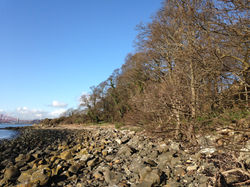Dalgety Bay Community Woodlands Group

 |  |  |  |  |  |  |
|---|---|---|---|---|---|---|
 |  |
Birds
Although there are many birds that live in or pass through the woodlands it may be that they are heard more often than they are seen. Early spring is the best time with the birds in full breeding plumage and using various vantage points for the males to declare their territories and intentions. There are less leaves on the trees at this time too so they are easier to see, though getting good photographs of them in the woods is always difficult.
Several birds are known, or suspected as breeding in the three woods. Crow; Song Thrush; Blackbird; Chaffinch; Greenfinch; Goldfinch; Blue tit; Great tit; Coal tit; Dunnock; Robin; Wren; Wood Pigeon. Others may breed here or in some of the other, perhaps wilder woods such as Letham Hill Wood; Magpie; Jackdaw; Greater Spotted Woodpecker; Stock Dove; Bullfinch; Siskin; Sparrowhawk; Kestrel; Tawny Owl; Long-tailed Tit; and Tree Sparrow. Blackcap Warblers have bred in previous years and other warblers such as Willow Warbler and Chiffchaff can be heard in the spring but probably breed elsewhere. Winter visitors include Redwing; Fieldfare; occasional Waxwing; Brambling; Redpoll; and continental Blackcap.
Of course, the woodlands also offer protection to the seabirds that feed along the shores of the Forth and whose sights and sounds are part of the experience of walking the coastal path and other woodland pathways.
 Song Thrush |  Song Thrush cracking a snail |
|---|---|
 Thrush Anvil Crow Wood |  The broken snail shells |
 Goldfinch Hopeward Wood |  Goldfinch Hopeward Wood |
 Dunnock Hopeward Wood |  Blue-tit Crow Wood |
 Greatt Tit Hopeward Wood |  Common Terns over the ForthSeptember sees the terns gathering together before beginning thier migration south |
 Grey HeronHerons can often be seen, especially at low tide, catching small fish among the seaweed. |